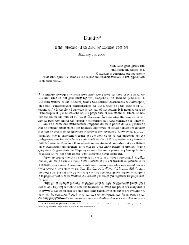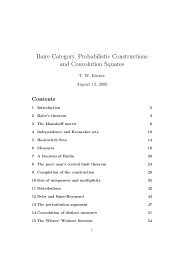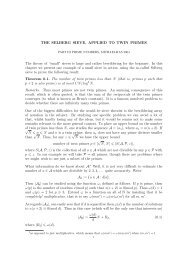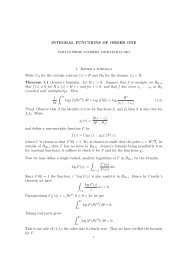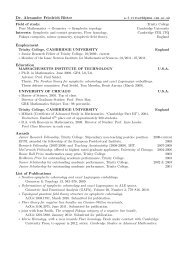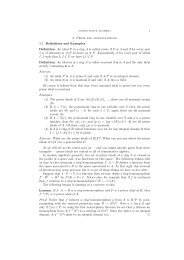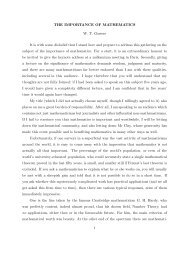Faces of Mathematics: Tony Scholl - Department of Pure ...
Faces of Mathematics: Tony Scholl - Department of Pure ...
Faces of Mathematics: Tony Scholl - Department of Pure ...
Create successful ePaper yourself
Turn your PDF publications into a flip-book with our unique Google optimized e-Paper software.
<strong>Faces</strong> <strong>of</strong> <strong>Mathematics</strong>: <strong>Tony</strong> <strong>Scholl</strong><br />
Marc Atkins and Nick Gilbert met with Pr<strong>of</strong>essor <strong>Tony</strong> <strong>Scholl</strong> at the University <strong>of</strong> Durham<br />
on the 29th May 2000.<br />
NDG: One <strong>of</strong> the things we are trying to do in this project is to give impressions <strong>of</strong><br />
mathematical research to the general public. I wondered when you first became aware <strong>of</strong><br />
mathematical research, mathematics in the pr<strong>of</strong>essional sense and began to perceive that it<br />
might be a possibility for you.<br />
AJS: Well that’s rather interesting. I think really very early on, though I wasn’t sure until<br />
quite late in life I wanted to be a mathematician, it certainly wasn’t until I was at university that<br />
I thought about that. I was nine when I discovered I had quite an aptitude for maths, reading<br />
books about the history <strong>of</strong> maths.<br />
NDG: So something quite special happened at age nine?<br />
AJS: No, not really. I had quite an inspiring teacher who gave me extra reading, a little book<br />
on calculus...<br />
NDG: At age nine?<br />
AJS: It was very elementary, explaining how you do differentiation, which seemed easy, and<br />
integration, which seemed harder... which in terms <strong>of</strong> mathematical sophistication seems the<br />
wrong way round! Then I became interested in physics as well. I had a physics teacher who<br />
pushed me towards physics, so I actually ended up going to Oxford to do physics. I didn’t have a<br />
great love for experiments and the theory didn’t really appeal to me in a great way. The things<br />
that I really liked were the structures, the mathematical aspects, so I became a mathematician<br />
with a vengeance. I think my tutors thought I would end up becoming an applied mathematician,<br />
so when I started studying algebra they were surprised.<br />
NDG: Did you find your undergraduate experience <strong>of</strong> mathematics at Oxford to be what<br />
you expected, or what you were looking for intellectually? It must have been stimulating in<br />
that you decided that you wanted to carry on and do postgraduate study.<br />
AJS: I think so. It was quite an unusual experience: I was quite young when I went to Oxford,<br />
and I enjoyed my time to the full. I did lots <strong>of</strong> things apart from mathematics.<br />
NDG: So you were younger than the standard undergraduate?<br />
AJS: I was the youngest person in my year: I was seventeen. If I had been an undergraduate<br />
with the intention to become a pr<strong>of</strong>essional mathematician, I think I would have done things<br />
differently. But it was all rather organic, and it was really only in the third year as an undergraduate<br />
that I decided I wanted to do research, and chose number theory because it seemed interesting,<br />
not because I knew much about it.<br />
NDG: So you were able to make a definite choice <strong>of</strong> that area <strong>of</strong> research?<br />
AJS: I felt my way in. I did a choice <strong>of</strong> courses in my third year that gave me various options,<br />
and I did toy with the idea <strong>of</strong> group theory for a while, though I didn’t find I had an aptitude for<br />
1
the technical stuff that finite group theory was all about at the time. So then I decided to go<br />
and work with Bryan Birch: well, not to go but to stay. And again I wasn’t really sure whether I<br />
was going to continue with that, or whether I was going to get my foot in the door <strong>of</strong> research<br />
and then go and do some thing different. It was all rather undecided, but it gelled in a particular<br />
way.<br />
NDG: The area that you work in - arithmetic algebraic geometry - can seem very forbidding<br />
even to a mathematical outsider. Do you have a way in which you could describe its<br />
concerns and aims that might be accessible to a non-specialist?<br />
AJS: You mean a non-mathematician...<br />
NDG: Even a non-mathematician, yes.<br />
AJS: When I’ve tried to talk to people, people in the street, about arithmetic algebraic<br />
geometry, there are some things you can describe. You can talk about Pythagoras’ Theorem, and<br />
explain that this gives rise to properties <strong>of</strong> numbers - Pythagorean triples - and that there are lots<br />
<strong>of</strong> interesting problems that arise from that. Although I’m not motivated by classical problems so<br />
much as by structure, and that’s what really fascinated me about arithmetic algebraic geometry.<br />
When I first started studying the theory, it seemed - well, a sort <strong>of</strong> Pandora’s box, all kinds <strong>of</strong><br />
different things, some completely unrelated and all rather unstructured. I remember looking at<br />
a book on Diophantine equations and thinking that was really rather strange: lots and lots <strong>of</strong><br />
seemingly unrelated problems. When I was a first-year graduate student, I started to learn some<br />
algebraic geometry and I took an instant liking to the structural aspects <strong>of</strong> it. Even algebraic<br />
geometry per se, as it is in the second half <strong>of</strong> the twentieth century, is a very beautiful mix <strong>of</strong><br />
algebra and geometry. That appealed to me because I feel happiest when I’m doing algebra, but<br />
I like to think geometrically.<br />
NDG: Do you see your approach to your own research more motivated by problem solving,<br />
or by theory building? Or are you equally concerned with those issues?<br />
AJS: I’m not really a theory builder: I think you have to be brought up in the French School...I<br />
think theory arises as a by-product <strong>of</strong> trying to solve problems. But just having a problem and<br />
solving it is not something that interests me in itself: I like solutions that have some surprise, and<br />
that is one <strong>of</strong> the really nice things about arithmetic algebraic geometry. You have some fairly<br />
concrete problems - the best problems are ones you can actually explain to the man on the street<br />
- you can’t perhaps explain the Riemann Hypothesis, but you can say that it is something related<br />
to the distribution <strong>of</strong> primes, and <strong>of</strong> course you can explain the Goldbach conjecture. And there<br />
are classical problems about elliptic curves that you can explain to a reasonably numerate person<br />
in the street: <strong>of</strong> course, you can explain Fermat’s Last Theorem. The beauty <strong>of</strong> these problems<br />
is that to get to grips with them, you have to put in an enormous amount <strong>of</strong> technical machinery<br />
and abstract structure, and that somehow justifies producing this structure.<br />
I remember that one <strong>of</strong> the first things I did after my thesis, I did some work on modular<br />
forms for non-congruence subgroups <strong>of</strong> the modular group. There was a collection <strong>of</strong> conjectures<br />
which Atkin and Swinnerton-Dyer had produced, essentially through computer experiment, about<br />
the arithmetic nature <strong>of</strong> these modular forms. I spent some time working on these and eventually<br />
found a solution: I’m not sure it was the solution, because not all the connections were perfectly<br />
formed, but certainly an explanation for all the phenomena that they had observed. I wrote to<br />
2
Swinnerton-Dyer explaining that I had done this, and I think he was probably rather horrified,<br />
because the apparatus that you needed to do this was incredibly sophisticated. It used all the<br />
mechanism <strong>of</strong> étale cohomology and crystalline cohomology as well. It was fun to do - I had to<br />
learn a lot <strong>of</strong> mathematics to solve it, but at the same time I felt that you could see how that<br />
very abstract cohomological structure can actually be use to solve relatively concrete problems.<br />
NDG: The subject seems to have been driven by key conjectures. Is there one problem, or<br />
class <strong>of</strong> problems, that has focussed your research interests?<br />
AJS: Well for some years, yes, but not entirely. There is an awful lot <strong>of</strong> the subject that<br />
is driven by the Birch-Swinnerton-Dyer conjectures and related things. I think that to a great<br />
extent the subject is driven by the relation between arithmetic and L-functions, and for quite a<br />
long time I have been doing things related to Beilinson’s conjectures which are generalisations <strong>of</strong><br />
the analytic class number formula to higher dimensional varieties. But in a sense even working<br />
on these things other structures emerge.<br />
Just recently I have been thinking about - in the time I have to think about mathematics,<br />
when I am not running the department - I have been thinking about representations <strong>of</strong> p–adic<br />
groups because <strong>of</strong> a problem which arose in connection with Beilinson’s conjectures. It was<br />
rather cute the way it arose because I made a mistake in writing the draft <strong>of</strong> a paper and I<br />
tried to understand why the mistake was a mistake and there was some phenomenon that looked<br />
interesting and might be worth trying to explain. I had an idea a few years ago which I worked<br />
out in a paper with Michael Harris, trying to make some evidence for Beilinson’s conjectures more<br />
consistent with what the conjectures should be, and that involved studying some properties <strong>of</strong><br />
representations <strong>of</strong> p–adic groups because the evidence was in connection with modular forms. In<br />
the course <strong>of</strong> writing this paper I noticed that there was a phenomenon which seemed not yet<br />
to have been observed by people working in the area. I’ve been thinking about that for a few<br />
months and maybe over the summer... I’ve got a particular conjecture which I want to work out.<br />
It’s not especially difficult, but it is quite interesting the way these things emerge.<br />
I don’t like to be too concentrated on one particular problem or one particular area, and that’s<br />
another thing about the subjects that is particularly nice: you have to know a lot <strong>of</strong> mathematics<br />
- algebra, topology, analysis, geometry. When I was a first-year student there was a conference in<br />
Oxford on Lie groups and somebody came and sat next to me in the c<strong>of</strong>fee room, who had come<br />
along to go to this conference, and he asked me what I was doing, so I said ”Number theory”.<br />
”Gosh, number theory” he said, ”that must be such a narrow subject.” I’m still amazed that<br />
anyone could have such a perception <strong>of</strong> number theory!<br />
NDG: When we spoke earlier, you said you were very excited about a piece <strong>of</strong> research<br />
that you were involved in. Was this the representation theory stuff that had really captured<br />
your imagination?<br />
AJS: Yeah - whatever I do, I get really gripped by it. You wouldn’t be a mathematician if you<br />
weren’t. It is a thing about representations and e-factors, which occur in the functional equations<br />
for L-functions. It is quite technical <strong>of</strong> course, but it is quite pretty as well. I don’t think the<br />
solution is going to be very exciting mathematically - which is why it suits me at the moment<br />
that I don’t have much time to do anything particularly exciting - I have to balance things,<br />
unfortunately, and I don’t have these long uninterrupted periods which are really necessary to do<br />
much really creative.<br />
3
NDG: So, as you said, being gripped by problems and being excited by problems is the very<br />
condition <strong>of</strong> success in being a mathematician. You also need some method for dealing with<br />
frustration or failure, and with making mistakes: do you have a particular approach to this?<br />
AJS: My approach to making mistakes is simple: I just make them. I make them quite<br />
unashamedly. I’m quite happy to make mistakes, because that is how you learn. Well, for me,<br />
that is how I learn. I’m very much a believer in the mathematical process being one <strong>of</strong> successive<br />
approximation. When you are teaching, that is something that students are terribly afraid <strong>of</strong>.<br />
They are brought up to feel that they mustn’t make mistakes, and that the most important thing<br />
is to get something right. The accuracy <strong>of</strong> what you come up with at the end is secondary to the<br />
process <strong>of</strong> understanding, as far as I am concerned. If I work on a problem and get it completely<br />
wrong, but I learn something in the process, then that’s great.<br />
NDG: I would certainly associate much <strong>of</strong> your work with Beilinson’s conjectures. Could<br />
you explain what those are really about?<br />
AJS: Well, perhaps the easiest way to explain is via one <strong>of</strong> the classical examples which are the<br />
motivation, and that is the analytic class number formula, which was discovered at the end <strong>of</strong><br />
the nineteenth century. It concerns the ζ–function <strong>of</strong> a number field. The ζ–function – defined<br />
in the same way as the classical Riemann ζ–function but using the integers <strong>of</strong> the number field<br />
instead <strong>of</strong> the natural numbers - has an analytic structure that is fairly well understood. There<br />
is a simple pole at s = 1 and the analytic class number formula is a formula for the residue at<br />
that pole. The ingredients that go into this formula are the class number <strong>of</strong> the number field -<br />
which is why it is called the analytic class number formula - the number <strong>of</strong> roots <strong>of</strong> unity that the<br />
number field contains, and the regulator, which is sometimes the most interesting part, because<br />
that’s the transcendental part <strong>of</strong> the number, which is the determinant <strong>of</strong> a matrix <strong>of</strong> logarithms<br />
<strong>of</strong> units. Beilinson’s conjectures are really a wild generalisation <strong>of</strong> that, in which the ζ–function<br />
<strong>of</strong> a number field is replaced by an L–function arising from an algebraic variety over the rationals<br />
- so a number field is the simplest example, it is just a 0-dimensional algebraic variety - and<br />
the numbers on the other side are replaced by things to do with the certain cohomology groups<br />
associated to the variety. The simplest, though not perhaps the right way to describe them, is to<br />
say they’re invariants associated to the higher K-groups <strong>of</strong> the variety. Those are the numbers<br />
that arise in the classical formula, because the class group is just the torsion subgroup <strong>of</strong> K0 <strong>of</strong><br />
the ring <strong>of</strong> integers <strong>of</strong> the number field, and the roots <strong>of</strong> unity occur in K1, and the units <strong>of</strong><br />
course are K1, so the regulator and the roots <strong>of</strong> unity measure in some sense the size <strong>of</strong> K1 <strong>of</strong> the<br />
ring <strong>of</strong> integers <strong>of</strong> the number field. So there is a rather fantastic generalisation <strong>of</strong> this, which<br />
include that and other conjectures as special cases. Beilinson’s original conjectures described<br />
the transcendental part: so they describe the value <strong>of</strong> these L-functions up to a rational factor.<br />
The determination <strong>of</strong> the rational factor requires more subtle ideas, and that’s essentially the<br />
substance <strong>of</strong> the Bloch-Artin conjectures. But a first approximation would be to try to get the<br />
thing correct up to a rational factor.<br />
I got interested in this because we had a working conference at Oberwolfach in 1985 to study<br />
Beilinson’s paper on his conjecture, which came out in the early 80’s. That was very interesting,<br />
because the mathematics that goes into just formulating the conjectures is fairly formidable. This<br />
was one <strong>of</strong> those conferences where if you go along, you have to volunteer to give some talks. So<br />
I and Norbert Schappacher gave several talks on one particular part <strong>of</strong> the paper which was on<br />
4
modular curves. While we were working on that, I had some ideas on how this might generalise<br />
to other L-functions <strong>of</strong> other modular forms. The time was just right, since I’d been working on<br />
what I mentioned before, on non-congruence subgroups, and I’d been looking at some problems<br />
to do with transcendence <strong>of</strong> coefficients <strong>of</strong> modular forms on non-congruence subgroups. And it<br />
seemed that there was some subtle algebro-geometric invariant that worked, and it was in the the<br />
process <strong>of</strong> trying to understand that, and after talking to various people who understood algebraic<br />
K-theory rather well - which I didn’t at the time - I realised that there must be something there,<br />
that would measure the deviation between congruence and non-congruence subgroups. So it was<br />
rather a surprise, as I was thinking about this, that I came across this work <strong>of</strong> Beilinson, and it<br />
turned out that he had thought about this for a completely different reason, and had just come<br />
up with the answer. So I was able to use that in looking at the higher-dimensional analogue <strong>of</strong><br />
L-functions.<br />
NDG: What is the status <strong>of</strong> these conjectures at the moment?<br />
AJS: Not much is known, really. A new idea is needed. A new idea is needed because at the<br />
moment, the only way we know to relate L-functions and arithmetic is through modular forms<br />
<strong>of</strong> one sort or another. There are classical modular forms on Dirichlet L-series and the Riemann<br />
ζ–function and such things, but they are modular forms <strong>of</strong> a very simple kind. Without such a<br />
connection we are completely lost. For example, all the deep results about the arithmetic <strong>of</strong> elliptic<br />
curves rely on the Shimura-Taniyama-Weil conjecture. Until that was known, all the results were<br />
for elliptic curves that had the property that they could be parametrised by modular functions.<br />
That’s sad, because what we now know from studying Shimura varieties and representation theory,<br />
is that you can’t hope to get hold <strong>of</strong> other varieties - even relatively simple ones like elliptic curves<br />
over imaginary quadratic fields. There’s no way <strong>of</strong> getting a handle on their arithmetic by studying<br />
the geometry <strong>of</strong> varieties associated to modular forms. They work very well for elliptic curves<br />
over Q , modular forms over GL(2, Q), but beyond that the arithmetic information that you are<br />
going to get about the objects that you want to associate to these particular forms, becomes<br />
scarcer and scarcer. So I think that what people have dreamt about is to have some wonderful<br />
cohomology theory for arithmetic varieties that would somehow be a substitute for the l-adic tale<br />
cohomology theory that proved so useful for studying varieties over finite fields. Some people<br />
have thought about that, and have thought about trying to actually produce such a cohomology<br />
theory, but not with any degree <strong>of</strong> success. There are no candidates, and no ideas <strong>of</strong> where a<br />
candidate might come from.<br />
NDG: So how does motivic cohomology fit into this?<br />
AJS: Well that’s very much on the geometric side. What you need is somehow - how can I<br />
put it? Look at classical algebraic number theory. A lot <strong>of</strong> the classical results - finiteness <strong>of</strong><br />
the class group, finite generation <strong>of</strong> the group <strong>of</strong> units - come about because you can embed<br />
the units <strong>of</strong> a number field, modulo the roots <strong>of</strong> unity, as a lattice in some Euclidean space and<br />
you can use some geometry <strong>of</strong> numbers to get a grip on it. Now that is what is really lacking<br />
when you are looking at varieties <strong>of</strong> higher dimension. Arakelov theory is the way in which this<br />
has developed, but still we don’t have an analogue for the logarithmic embedding <strong>of</strong> the group<br />
<strong>of</strong> units, not an analogue that we can actually do anything with. We don’t know that any <strong>of</strong> the<br />
K-groups <strong>of</strong> these algebraic varieties are finitely generated, except in some very special cases.<br />
Some <strong>of</strong> the ones that we can produce finiteness results for, the methods <strong>of</strong> pro<strong>of</strong> use p-adic<br />
5
analysis, quite subtle things. In our dream world, we’d have an arithmetic cohomology theory<br />
that associated to an algebraic variety certain infinite-dimensional spaces with extra structure,<br />
which you could use to construct L-functions to prove that they had nice analytic properties. If<br />
you had such a machinery, things like the Riemann Hypothesis would come out as properties <strong>of</strong><br />
these operators. But at the moment that is still a dream, not a dream that I’ve been working on<br />
in any serious way myself, but there are people who have been. It is well known that Connes has<br />
been thinking about the relationship between the Riemann Hypothesis and foliation theory. I’m<br />
not an optimist: I think this is a dream <strong>of</strong> the way things might be, rather than a dream <strong>of</strong> how<br />
they are, and it such a long way from present knowledge. I think that what is really needed is a<br />
few more startling ideas.<br />
NDG: Are you an optimist about the conjectures themselves?<br />
AJS: I am an optimist, in that the conjectures have a lot <strong>of</strong> internal logic, and it is hard to<br />
imagine they could be otherwise. Other conjectures I’m not sure I’m so optimistic about. I see no<br />
reason to be particularly optimistic about Goldbach’s conjecture. It wouldn’t disturb me greatly<br />
if it turned out that there were a few gaps. But the evidence, the internal logic, <strong>of</strong> the Riemann<br />
Hypothesis is a different matter. It has analogues over finite fields which are known to be true,<br />
and I think that I’m an optimist in that respect. I’m not so optimistic about a pro<strong>of</strong> being found<br />
in my lifetime. But I don’t really care that much!<br />
NDG: When you’re working in this area, do you tend you work with the background assumption<br />
that the conjectures are true, or does that not impinge on the technical details?<br />
AJS: Yes, because... in this case I’ve never looked at the case <strong>of</strong> what would happen if they<br />
were false... It’s not the kind <strong>of</strong> thing... Life would be messy, that’s probably the best way <strong>of</strong><br />
putting it!<br />
NDG: Is Beilinson himself still active?<br />
AJS: Yes, he does lots <strong>of</strong> things. At the moment he’s thinking more about quantum groups.<br />
I saw him just over a year and a half ago at a conference in Germany, and he gave me a copy <strong>of</strong><br />
a preprint he had about motives, so he is thinking about these things as well.<br />
NDG: If we could turn from the technicalities <strong>of</strong> your research to the practicalities. Do<br />
you tend to or prefer to work on your own, or with collaborators?<br />
AJS: I’m not a great collaborator. I’ve never really worked on a single problem jointly with<br />
someone else. It would be quite interesting to do so, because I don’t know... the dynamics <strong>of</strong><br />
such a working environment must be very interesting. It just suits me to work by myself.<br />
NDG: Do you have a preferred place in which to work?<br />
AJS: Not really, no. Some people say that they like to work at home. I like to work in places<br />
where there are no distractions, which usually means not in the <strong>of</strong>fice, but can mean not at home<br />
as well! Somewhere different actually, where there are no distractions at all... in a hotel room.<br />
NDG: What about places like Oberwolfach that you mentioned earlier?<br />
AJS: The trouble with Oberwolfach is that there is so much going on. I do <strong>of</strong>ten work there,<br />
but if I do, I find I don’t get very much sleep. Early starts and working until nine o’clock at night<br />
6
- and I do like working into the late hours - that’ s certainly true, I do have a preferred time <strong>of</strong><br />
working, and that tends to be late in the day. Sometimes I’ve worked all through the night, and<br />
that can be quite pleasant, provided you haven’t got any terrible commitments the next day. I<br />
find it very difficult to work and to know that I’ve got to stop. Snatching half an hour at a time<br />
is just not... unless there’s a particular thing which I want to do and I think I can do in that<br />
space <strong>of</strong> time... I find it very difficult to think when there’s a horizon.<br />
NDG: When you are engaged by and thinking about research, do you think that you are a<br />
different <strong>Tony</strong> <strong>Scholl</strong> from the person who goes about and does the rest <strong>of</strong> life?<br />
AJS: Oh, definitely. Certainly I’m a different person to speak with, from what I’ve been told!<br />
But I feel it too: when I stop working and do other things, like domestic things or to go for an<br />
evening out, I feel that only half <strong>of</strong> me has come back to the real world.<br />
NDG: Does that kind <strong>of</strong> state last for hours, or days, or weeks?<br />
AJS: Well, days: a day probably. At the moment I can only manage that if I go on sabbatical.<br />
NDG: So as Head <strong>of</strong> <strong>Department</strong>, we may be talking minutes...<br />
AJS: Unfortunately, yes. Trains are a good place to work: an uninterrupted three hours down<br />
to London, except that I can never read my notes. And there’s a problem with the paper, because<br />
I like to spread the paper out everywhere, so it does spread to the floor <strong>of</strong> the railway carriage...<br />
NDG: Your fellow passengers are holding back the progress <strong>of</strong> mathematical research...<br />
AJS: Oh, I had a great time with Bryan Birch. We were on a train, I think we’d gone down to<br />
London for some reason, and we were talking about mathematics. Bryan was saying something<br />
about this cow’s stomach, and you have to cut it here, and cut it there, and glue these pieces<br />
together... and there was a person sitting opposite who was completely perplexed, and I think<br />
rather worried, and didn’t realise that these mathematical metaphors were that, and thought we<br />
must be completely mad.<br />
NDG: Do you take any philosophical stance on what you are doing? People might regard<br />
mathematics as a formal game, or as the discovery <strong>of</strong> absolute truths.<br />
AJS: Am I a Platonist? I suppose I am, though perhaps not in the strictest sense. I’m<br />
not really a formalist. I’m not sure that the question is all that meaningful, because once the<br />
mathematics has been discovered, it is there and you can’t uninvent it, you can’t say it wasn’t<br />
there before. I’m not sure that is a very meaningful question. Is there a universal mathematical<br />
truth? I think most people think there is. It must be very hard to do mathematics unless you<br />
think that the rules are fixed. Although one knows there are set-theoretic problems, I’m not<br />
one <strong>of</strong> those people who worries about these things. I think I take a fairly cavalier attitude to<br />
foundations.<br />
NDG: Do you have any analogy for the processes <strong>of</strong> mathematical research? Do you find<br />
analogies in art, or music, or chess playing, or anything <strong>of</strong> that kind? To give you an example<br />
that Tim Gowers <strong>of</strong>fered us, there was a toy that his son had been given, a manipulation<br />
puzzle with cars and lorries and so on. Tim said he had played with this for ten minutes,<br />
and he realised it was really like mathematics: he wanted to get a truck from this corner<br />
to that corner, and to do that you had to move the car first, and to do that you had to<br />
7
move the people. Tim had played this for ten minutes and thought that it was a bit like<br />
doing mathematics, in that if you wanted to explain to someone what the process <strong>of</strong> doing<br />
mathematical research was like, you could give them this puzzle, and say ”Try and do this:<br />
get the truck from this corner to that corner”.<br />
AJS: I prefer what Andrew Wiles said at the beginning <strong>of</strong> that Horizon documentary. It was<br />
exactly how I felt about doing mathematical research: it is like walking into a darkened room,<br />
and there’s just furniture in it, and you don’t know what’s there, and you just feel to get the<br />
shapes. It is much more like that, as I see it. I like doing recreational puzzles, but not in a very<br />
serious way as some mathematicians do. I don’t see that for me, doing mathematical research is<br />
not the same process as solving puzzles, because I’m always thinking about structure.<br />
NDG: Geometric structure?<br />
AJS: Geometric structure, but possibly algebraic structure. I think if I had to pigeonhole<br />
myself, I’d settle for algebraist. I was thinking <strong>of</strong> this very question a few days ago, and I had a<br />
very good analogy that I’d thought <strong>of</strong>, but has now escaped my mind.<br />
NDG: Do you see any connection between the music that you like to play and the way<br />
you approach mathematics? Do you like particularly structured music, or music where there<br />
is a sense <strong>of</strong> discovery?<br />
AJS: One <strong>of</strong> the things that makes a good piece <strong>of</strong> music for me is that you can listen to<br />
it many times, and that each time you hear it there is something new to discover. You unwrap<br />
a particular level <strong>of</strong> complexity, a particular formal level. My musical taste is perhaps not what<br />
you would expect from a mathematician, for traditionally mathematicians are supposed to favour<br />
Bach, and are not supposed to like the romantic nineteenth century stuff. My tastes are pretty<br />
wide, and I enjoy nineteenth century music greatly. I do like to have some structure.<br />
NDG: How about twentieth century music?<br />
AJS: The problem with twentieth century music is that you have to spend a lot <strong>of</strong> time<br />
listening to it before you get anything out <strong>of</strong> it at all. I’m intrigued by twentieth century music:<br />
intrigued from a purely academic point <strong>of</strong> view, the way in which twentieth century developed.<br />
I’m talking about the first half <strong>of</strong> the twentieth century, because the second half is rather chaotic,<br />
and music seems to have fragmented considerably.<br />
NDG: Have you ever found appealing the sort <strong>of</strong> music that is supposed to have some<br />
direct connection with mathematics, say Xennakis or Lutoslawski?<br />
AJS: As far as order... I’m not sure that there is anything intrinsically mathematical about<br />
the serial approach to music: it is a structure within which one can compose. That’s my interest<br />
in listening to such a piece <strong>of</strong> music: I’m aware that there is a structure within which it is written.<br />
I don’t think there is much intrinsic beauty in that structure. Now Xennakis is rather different. I<br />
never really understood the mathematical complexities that he is using in his so-called stochastic<br />
music. I don’t know if it possible to write stochastic music. It is almost a contradiction in terms.<br />
Once I was at Oberwolfach, and I saw a book there, which I have never been able to find<br />
since. It was a proceedings <strong>of</strong> some conference on mathematics and music, and the people who<br />
were writing there were trying to use sophisticated mathematics as a basis for writing music -<br />
group theory - they were using algebraic structures to formalise their musical language. I saw<br />
8
this on a bookshelf, and thought that I must have a look at this when I have some time, and I<br />
didn’t make a note <strong>of</strong> what it was, and I’ve never found it since.<br />
NDG: Thinking again <strong>of</strong> the mathematics that you do, is there something that you would<br />
like to achieve in the nest five, ten, or however many years, that you would see as a long<br />
term aim or ambition?<br />
AJS: You mean particular projects? I don’t have any projects that I’m thinking <strong>of</strong> as a problem<br />
I’d like to solve in the next five or ten years. I don’t think I’ve ever thought that way - well,<br />
not for some time. I prefer much more thinking about a general area in which I work, and the<br />
problems almost arise simultaneously with the solutions. I have a couple <strong>of</strong> other projects which<br />
I have been thinking about, and as I work on them more they’ll probably develop into something<br />
very different. I don’t have any specific ambitions, except to stop being Head <strong>of</strong> <strong>Department</strong><br />
before I retire.<br />
NDG: And then they’ll be time to think about projects...<br />
AJS: Really, it is like trying to drive a car with just one cylinder working...<br />
NDG: Which other mathematicians, in your area or more widely, have you particularly<br />
admired? Obviously Bryan Birch, as your graduate supervisor, would have been a big influence.<br />
But are there others whose ideas and style have been particularly influential?<br />
AJS: I don’t know so much about style and ideas, but there are certainly other mathematicians<br />
whose work I’ve admired and studied. I’d really have to say Deligne is one such person: his work is<br />
amazing, and his writing has such insight. In just a paragraph, he can in such a succinct way... it<br />
is a combination <strong>of</strong> being precise and detailed, and at the same time just showing you the insight.<br />
It is possible to write in a very formalistic way, in such a way that everything is completely clear,<br />
and to understand it all in the sense <strong>of</strong> understanding how you get from one line to the next, but<br />
at the same time being very dry. His writing is never dry: it is very iridescent, and full <strong>of</strong> ideas<br />
even when he isn’t solving problems. It is very inspirational to read.<br />
9



